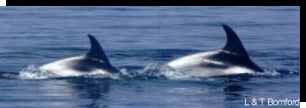|

The whitebeaked dolphin in the Orion Belt. Is the Orion Belt a nursery for the whitebeaked dolphin? Is the population in the Orion Belt stable, are the same individs returning every year etc.. For details go to the custom pages 2,3 and 4.
WHERE, WHEN, WHO AND WHY.
The whitebeaked dolphin projects in field research is so fare scheduled to take place from June to November 2001 plus March to November 2002.
The research area is an area between Skagen Reef and the Norwegian Trench, also called the Orion Belt. The Orion Belt is a very important ecological area. The deapth in the Orion Belt varies between 50 and 700 meters. It is an extreemly fertile area, where winterstorms press the cold and relativly salty North Atlantic currents into the warmer and less salty waters of the North Sea.
This process brings water from the bottom layers towards the surface, where fotosynthesis is the basis for the growth of plant plankton, which again is the basis for animal plankton, which is the basic food supply for fish, which again are eaten by dolphins.
The Orion Belt is the area, within the Danish waters, where most sightings of cetaceans are registered, many of them are sightings of whitebeaked dolphins.
The whitebeaked dolphin in the Orion Belt project takes place under participation of the marine research organisation Viking Explorer, as well as researchers from Copenhagen Universities Zoological Museum plus Danmarks Miljoeundersoegelser, D.M.U..
WHY STUDY THE WHITEBEAKED DOLPHIN
If to say that other spacies of cetaceans are already studied or part of some research program, it does not neccessarily mean, that enough is done on this front. Anyways, the whitebeaked dolphin is one of the least studied cetaceans in the North Sea, and very little is known about it in general, not to speak of the population in the Orion Belt in particular.
There are still many unanswered questions, even about the whitebeaked dolphins general biology, and the board of Viking Explorer agreed with biologist Carl Christian Kinze, at Copenhagen Zoological Museum, that a research project in this field is most urgent.
The projects modules and the participiants.
THE PROJECT CONSISTS OF THE FOLLOWING MODULES.
Photo-ID Viking Explorer / Lytken and Rasmussen
The aim of the Photo-ID is to estimate the size of the population of whitebeaked dolphins in the Orion Belt, as well as its dispersion over the area and the time of their presence there.
Furthermore we are trying to answer the following questions. Are the whitebeakes in the area returning year after year? How big is the homerange of whitebeaks? Can we recognize individuals from Rasmussens Photomaterials from Island, 98/99 and from the area off the western coast of Scotland, from P.G.H.Evans photomaterials? Are whitebeaks giving birth to calfs in the Orion Belt, if so, is there any particular, preferred area, where is it and when does it take place and how long are they there? etc.....
Finally. Researchers from the Morey Firth project state, that they can identify symptoms from 16 different dermal diseases on bottlenose dolphins. We are looking into the possibilities for enhancing the results from the biopsies by using photgraphic materials from the photo-IDs.
TRANSECT-OBSERVATION by Zoological Museum.
The last transect in the Northern Sea, including whitebeaks was the SCANS survey in 1996, which estimated the population of whitebeaks in the entire North Sea, including Skagerak,the English Channel and the Irish Sea to 8.000 individs. Naturally the Orion Belt is a far smaller area, but it is probably an important one.
The transect observation will basically answer the same questions about the size and dispersion of whitebeaks in the area as the Photo-ID. It will be extreemly interesting to make comparative studies of the results of the Photo-ID results and the Transect observation.
SATELLITE TRACKING by D.M.U.
Also satellite tracking of individuals will answer qquestions about the whitebeaks migrations, homerange, eventually about contact with other populations and about preferred areas, such as the question weather whitebeaks prefer to stay close to the continental shelves area, if so, at what time of the year etc...
SOUNDPRODUCTION AND ECCOLOCATION, Viking Explorer, Marianne Rasmussen.
Please visit us soon again to read more about soundproduction and echolocation.
NIGHT OBSERVATIONS, Viking Explorer
By observing whitebeaks at night we will for the first time be able to tell wether whitebeaks use their eccolocation at night or during resting periods, and maybe it will be possible to use the data we geather to prevent unintended bycatches during night fishery.
BIOPSY SAMPLING by D.M.U.
From Biopsies we try to get information about genetic connections between various groups of whitebeaks as well as eventually other populations.
Furthermore will biopsies tell tales about toxins such as PCBs and PAHAs in the blubber of whitebeaks.
For detailed information about the project modules go to custom pages 2,3 and 4
CUSTOM PAGE 2 ABOUT VIKING EXPLORERS RESEARCH
CUSTOM PAGE 3 ABOUT ZOOLOGICAL MUSEUMS RESEARCH
CUSTOM PAGE 4 ABOUT D.M.U.s RESEARCH
For general information about Viking Explorer or membership applications go to our PR-website at www.vikingexplorer.20m.com
our administration
vikingexplorer@newmail.dk |
 |
Support our research, become sponsor or advertize in our websites.
For sponsorship agreements or advetizing in our websites, write to
Marine Research Organisation Viking Explorer
Peter Ipsens Alle 3 3rd 67
Dk - 2400 Copenhagen NV
Denmark
Att.Secretary Irina Lehmann
|